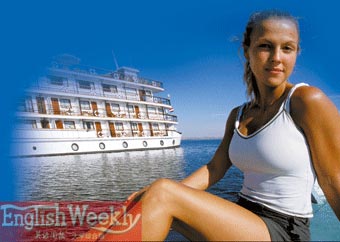|
|
|
沿尼罗河扬帆而行http://www.sina.com.cn
2007年04月03日 00:27 英语周报大学版
Sailing down the Nile 沿尼罗河扬帆而行 (2006-2007学年 第13期) By Ann Givens AND Rafer Guzmán 刘颖 译
 沿尼罗河扬帆而行
 尼罗河帆船上惬意小憩 [1]Aswan, Egypt — By the time we stepped off the crowded sidewalk into the Aswan Moon restaurant, we were sun-sick and exhausted from hours of pushing through the streets of Egypt’s southernmost city. We collapsed at a shaded table overlooking the Nile and asked the waiter to introduce us to a man called “Captain Washington.” [2]We had not yet decided whether we were up to a two-day sail up the Nile in a 20-foot wooden boat called a felucca1. Climbing aboard a tiny boat with two Nubian sailors for 48 hours was a leap of faith. We would be sleeping on deck, eating whatever food they prepared, washing up with Wetnaps. The concierge at the Cairo Marriott had laughed when we told him we were considering such a trip, and offered to book us a room on one of the Nile’s many cruise ships. Looking at those ships now, their decks dotted with bikini-clad tourists drinking mimosas, we wondered if we had made a mistake. [3]Of course, we had to be a little brave to choose Egypt as our vacation destination in the first place. Strife in the Middle East, and several terrorist attacks at Egyptian tourist destinations during the past several years, have made it a place that some travel agents don’t recommend. [4]That city, which sits on the banks of the Nile about 100 miles north of the Sudanese border, marks — both geographically and culturally — the line between the Middle East and Africa. [5]The Nile is gorgeous in Aswan, and the city is home to a wonderful museum, market and breathtaking antiquities. Moreover, it’s the departure point for day trips to one of Egypt’s most spectacular sites: the towering temples of Abu Simbel on the border with Sudan. [6]Traveling by felucca isn’t for everyone. The boats are small, about 20 feet long by 9 feet wide, and powered by a single sail. Passengers sit on a wide platform covered with cushions, and that’s also where they sleep. A simple canopy helps block the sun and wind. [7]This is the way Egyptians traveled for centuries, at least since the Middle Ages when the term felucca was coined by Italian visitors. In those days, there were reportedly tens of thousands of sailboats traversing the Nile. The boats are rarer sights today, as tourists increasingly opt for the faster, fancier cruise ships. [8]As we watched the city of Aswan drift away on our first day out, the first thing we noticed was the silence. We sat on the cushioned deck, in the shade of a canopy, as the sun-bleached shores of the Nile went by like a beautiful, colorful silent film. First we watched the bustle of downtown Aswan, where giant cruise ships lined the banks, and tourists in sun hats enjoyed early lunches at riverside restaurants. [9]Then, as we neared the west bank of the Nile, we could see the ancient ruins, Tombs of the Nobles, where the princes and governors who ruled Egypt more than 4,000 years ago are buried. And within an hour, we had entered the no-man’s-land between Aswan and Luxor to the north, where all there is to see are the green hills and farms at the river banks, disturbed only by the occasional wake of a cruise ship. For the most part we sailed along silently, reading, napping, and enjoying the view. [10]Our schedule was nothing if not flexible, so we took impromptu side trips into small villages along the way. At one, we toured a Nubian house decorated in complex beadwork that recalled the stained-glass windows of European cathedrals; in another, we bounced along in a Jeep to see the local camel market, where merchants proudly showed off their herds. We even made a beer run, pulling to shore to buy a few bottles of Egyptian Stella from the back of a truck. By the time we reached the temple of Kom Ombo, where the captain had arranged to drop us off the morning of our third day, we had gotten used to this carefree life. 沿尼罗河扬帆而行 参考译文 [1]埃及阿斯旺——在埃及最南部的这座城市里,大街上人们熙来攘往,我们在拥挤的街道上穿梭了几个小时,才走进阿斯旺月亮餐馆。这时,我们已经是疲惫不堪,几乎要中暑。我们走到阴凉处的一张餐桌前,瘫坐了下来,这儿能俯瞰尼罗河,我们请侍者为我们引见了一个叫做“华盛顿船长”的人。 [2]我们还没有下定决心是不是要乘坐一种长约20英尺、叫做“三桅小帆船”的木船沿尼罗河航行两天。坐在这样一艘小船上,和两个努比亚水手一起共度48个小时,那是需要冒很大的风险的。我们要睡在甲板上,吃他们准备的食物,用湿巾洗手洗脸。听说我们打算做一次这样的旅行,开罗马里奥特酒店的服务员哈哈大笑,并主动表示可以为我们在一艘尼罗河游船上预订房间。此时,我们看着那些游船,看着许多身穿比基尼泳装的游客在甲板上喝着橙汁香槟酒,不知道自己是不是做了个错误的决定。 [3]当然,选择到埃及来度假,一开始就需要一点勇气。在过去几年里,中东地区冲突时有发生,埃及的几处旅游区也遭受过几起恐怖袭击,因此有些旅游社不建议游客去埃及旅游。 [4]阿斯旺这座城市坐落在尼罗河畔,位于苏丹边境以北大约100英里的地方,因此,不论是从地理上还是从文化上,阿斯旺都是中东地区和非洲的分界线。 [5]尼罗河流经阿斯旺的那段水域风光迷人,而且这座城市里还有一座绝妙的博物馆,一个极好的市场,很多令人兴奋不已的古董文物。此外,阿斯旺还是动身前往埃及最壮观的景点之一(位于苏丹边境的阿布辛拜尔神庙)做短途旅行的出发点。 [6]并不是人人都适合乘坐三桅小帆船航行。这种帆船非常小,长约20英尺,宽约9英尺,凭单帆驱动。乘客就坐在一块宽阔的平台上,上面铺着软垫,那里也是乘客睡觉的地方。为乘客遮挡风吹日晒的只有一张帆布篷而已。 [7]中世纪时期,意大利游客创造了“三桅小帆船”这个名词。如果从那时算起,埃及人驾驶着这样的小帆船航行的历史,至少有几百年了。据说当时有成千上万的帆船在尼罗河上航行,而今天这种帆船已经非常罕见了,因为越来越多的游客选择了速度更快、装饰更豪华的游船。 [8]在乘小帆船出行的第一天,随着阿斯旺市离我们越来越远,我们首先发现的便是寂静。我们坐在铺着软垫的甲板上,躲在帆布篷遮蔽的阴凉中,看着让太阳光晒得白花花的尼罗河河岸像一部美丽而多彩的无声电影从我们眼前掠过。我们首先看到的是喧嚣繁忙的阿斯旺市区,一排排大型游船停泊在岸边,戴着太阳帽的游客们早早地就在河畔餐馆享用午餐了。 [9]接着,小船靠近尼罗河西岸的时候,我们可以看到远古的遗迹——贵族墓,那里安葬的是4000多年前统治埃及的贵族王公。不出一个钟头,小船驶入了阿斯旺和卢克索以北的无人地带。放眼望去,两岸只有青翠的山岭和农场,偶尔有一艘游船打此经过,除此之外便是寂静。大部分时候,我们都是在静静地航行,或是读书,或是打盹儿,或是欣赏美景。 [10]由于我们的航行计划非常灵活,沿途我们又随兴游览了几个小村落。在其中一个村子里,我们参观了一所努比亚人的房屋。这所房屋上有着令人眼花缭乱的串珠状装饰,令人不禁想起欧洲大教堂的彩色玻璃窗。在另外一个村子里,我们坐着吉普车一路颠簸着赶到当地的骆驼市场,看商人们在那里骄傲地夸耀自己的牲口。我们甚至还去购买啤酒,把船停靠在岸边,在一辆卡车的后面买了几瓶埃及斯特拉啤酒。第三天早上,我们到了康翁波神庙,我们的船长打算把我们搁在那里。此时,我们已经习惯了这种无忧无虑的生活。
【发表评论】
|